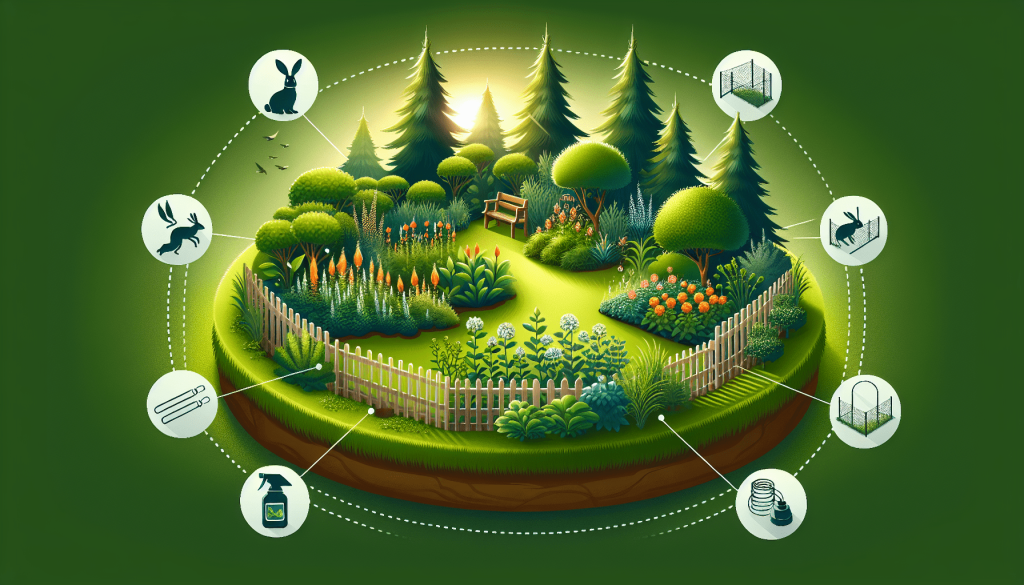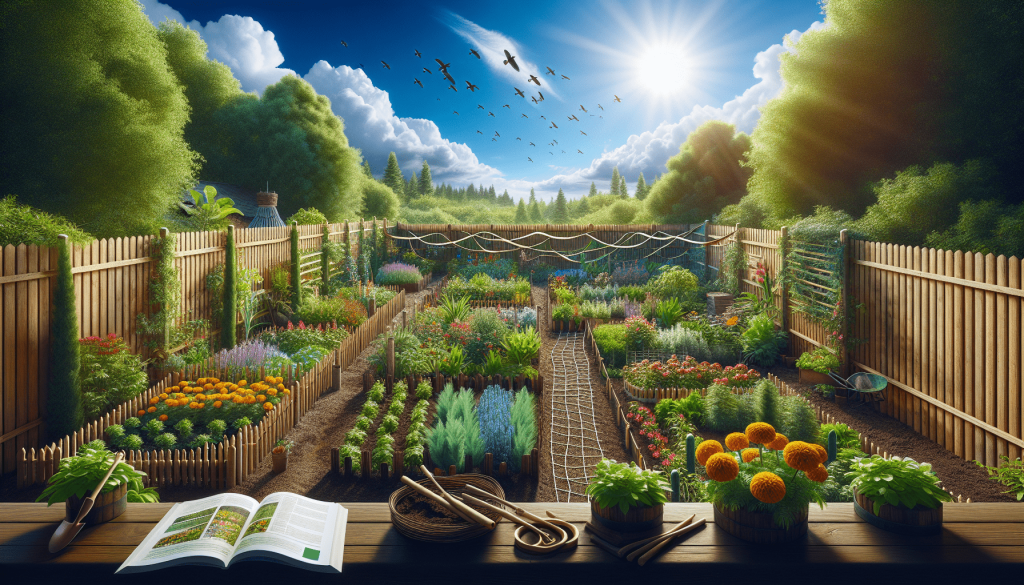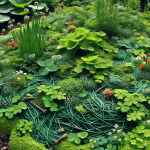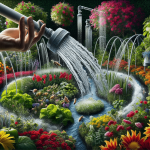This post may contain affiliate links. As an Amazon Associate, we may earn commissions from qualifying purchases.
Have you ever found yourself frustrated with wildlife invading your garden and devouring all your hard work? Well, if you’re wondering how to keep pesky creatures like deer or rabbits away from your precious plants, look no further. In this article, we’ll explore some effective methods and tips that will help you protect your garden and maintain its beauty. So, say goodbye to nibbled leaves and hello to a flourishing, critter-free oasis.

Fencing
Wire Mesh Fencing
One of the most effective ways to protect your garden from wildlife is by installing wire mesh fencing. This type of fencing is built with small openings that prevent animals like deer and rabbits from squeezing through. It creates a physical barrier that keeps them out of your garden. Wire mesh fencing is quite durable and can withstand harsh weather conditions, making it a long-lasting solution for protecting your plants.
Electric Fencing
Another option to consider is electric fencing. This type of fencing uses a low-voltage electrical charge to deter wildlife from entering your garden. The mild shock they receive when touching the fence acts as a deterrent, teaching them to stay away. Electric fencing is particularly useful for deterring larger animals like deer. However, it’s important to ensure the safety of other animals and humans, so be cautious when using this method.
Deer-Proof Fencing
Deer are notorious for causing damage to gardens, so if you live in an area with a high deer population, you may want to consider investing in deer-proof fencing. This type of fencing is specifically designed to keep deer out of your garden. It typically features tall vertical wires placed close together to prevent deer from jumping over. The bottom of the fence should be buried a few inches underground to prevent them from burrowing under. Deer-proof fencing is a reliable solution for preventing extensive damage to your plants.
Natural Deterrents
Plants That Repel Wildlife
Using plants that repel wildlife can be an effective way to protect your garden. Certain plants naturally contain compounds that animals find unappealing, deterring them from venturing near your plants. For example, planting marigolds or garlic can help deter rabbits and deer due to their strong scent. Additionally, lavender is known to repel deer. By strategically incorporating these repellent plants throughout your garden, you can create a natural barrier against wildlife.
Scare Devices
Scare devices are a popular method for keeping wildlife away from your garden. These devices use motion or noise to startle animals and make them think twice before entering your garden. Motion-activated sprinklers, for instance, will shoot out a burst of water as soon as they sense movement. This unexpected spray will discourage most animals from approaching your plants. Another simple and inexpensive method is hanging aluminum pie pans or wind chimes, as the shiny and noisy objects will create a deterrent effect.
Predator Urine
Using predator urine is a natural and chemical-free way to keep wildlife at bay. The scent of predator urine, such as coyote or fox urine, tricks animals into believing that a predator is nearby. This can effectively deter rabbits, deer, and other animals from your garden. Predator urine can be purchased at gardening stores or online and can be strategically placed around the perimeter of your garden to create a sense of danger for wildlife.
Physical Barriers
Netting and Covers
Netting and covers are beneficial for protecting your crops from small animals like rabbits and birds. Using nylon or wire mesh netting can prevent these animals from accessing your garden and damaging your plants. Simply place the netting over your crops and secure it tightly using stakes or weights. This physical barrier allows sufficient airflow and sunlight while keeping unwanted creatures at bay. Additionally, covers made of lightweight fabric can be used to protect individual plants or seedlings from pests.
Raised Beds
Building raised beds can serve as a physical defense against wildlife. Raising your garden beds off the ground makes it harder for animals to access your plants. It can be particularly effective in deterring rabbits, as they are less likely to jump into raised beds. Raised beds can be constructed using various materials, such as wood or stone, and can be customized to fit your garden’s layout. Not only do they provide a protective barrier, but they also offer improved drainage and soil quality for your plants.
Row Covers
Row covers are essential for safeguarding your plants against insects and small animals. These covers are made from lightweight fabric that allows sunlight and water to reach your plants while keeping pests out. They create a physical barrier that prevents insects and rabbits from feeding on your crops. Row covers are easy to install and can be secured with stakes or weights. They are particularly useful for protecting delicate plants during the early growing stages.
Individual Plant Protection
Sometimes, certain plants require extra protection from wildlife. Individual plant protection can be achieved by using cages, barriers, or cloches. These methods involve creating a physical barrier around vulnerable plants to prevent animals from reaching or nibbling on them. Cages can be built using wire mesh or chicken wire, while barriers can be constructed using fences or mesh screens. Cloches, on the other hand, are transparent domes that cover individual plants, offering protection from pests while creating a mini greenhouse effect.
Repellents
Homemade Repellents
Homemade repellents are an affordable and eco-friendly option for protecting your garden from wildlife. These repellents often use natural ingredients that animals find unpleasant, deterring them from approaching your plants. For example, mixing garlic, chili peppers, and water to create a spray can help repel rabbits and deer from your garden. Similarly, a mixture of soap flakes and water can deter insects and small animals. Homemade repellents can be applied directly to plants or sprayed around the perimeter of your garden.
Commercial Repellents
If you prefer ready-made products, there are plenty of commercially available repellents designed to keep wildlife away from your garden. These repellents often use a combination of natural and synthetic ingredients to create a potent deterrent effect. They come in various forms, such as sprays, granules, or pellets, and target specific animals, including rabbits, deer, or insects. Commercial repellents are convenient to use and can provide effective protection for your garden when applied according to the instructions.

Gardening Techniques
Interplanting
Interplanting refers to the practice of growing different types of plants together in close proximity. This technique can be beneficial for deterring wildlife, as certain plants naturally repel pests while attracting beneficial insects. For example, planting onions or chives among your crops can help deter rabbits and deer due to their strong smell. Additionally, marigolds are known to repel insects. By interplanting these species strategically, you can create a diverse and pest-resistant garden.
Crop Rotation
Crop rotation involves changing the planting location of different plant families each growing season. This technique helps minimize the risk of pests and diseases, including those that are caused by wildlife. By rotating crops, pests that were attracted to specific plants the previous year may have difficulty locating them, reducing the damage caused to your garden. Additionally, rotating crops can help maintain nutrient balance in the soil, leading to healthier plants overall.
Companion Planting
Companion planting involves growing compatible plants together to benefit one another. Selecting certain plants that naturally repel pests or mask the scent of desirable crops can help protect your garden from wildlife. For instance, planting strong-smelling herbs like basil or rosemary alongside vulnerable crops can deter rabbits and deer. Additionally, certain flowers like marigolds attract predatory insects that feed on garden pests. Companion planting is a sustainable and natural way to deter wildlife while promoting the health of your plants.
Plant Selection
Choosing the right plants for your garden can significantly reduce wildlife-related issues. Selecting varieties that are less appealing to animals can decrease the likelihood of damage. For instance, rabbits and deer tend to avoid plants with strong scents, such as herbs, or those with fuzzy or prickly leaves, like lamb’s ear or thistles. Researching which plants are less attractive to wildlife in your area can help you make informed decisions when planning your garden and minimize the risk of damage.
Garden Maintenance
Pruning and Trimming
Pruning and trimming your plants regularly not only promotes their overall health but can also deter wildlife. Overgrown plants create hiding spots and shelter for animals, making your garden more inviting. By maintaining your garden’s neatness, you eliminate potential nesting areas and reduce the attractiveness of your plants to wildlife. Trim back branches, bushes, and ground cover regularly to discourage animals from taking up residence in your garden.
Regular Harvesting
Harvesting your crops in a timely manner is crucial for preventing wildlife damage. Leaving ripe fruits and vegetables in the garden for too long can attract not only animals but also insects. By promptly harvesting produce when it reaches maturity, you reduce the likelihood of wildlife showing interest in your garden. Regular harvesting also allows you to enjoy the fruits of your labor at their peak flavor and freshness.
Removing Attractants
Eliminating attractants in and around your garden is essential for minimizing wildlife-related issues. Removing fallen fruits, vegetables, or any other food sources that animals find appealing can help deter them from frequenting your garden. Ensure that garbage cans and compost bins are properly sealed to prevent odors from attracting wildlife. Clear away any debris, such as piles of leaves or branches, as these can serve as potential hiding spots for animals. By removing attractants, you make your garden less enticing to wildlife.
Hunting or Trapping
Legal Considerations
If wildlife damage to your garden persists despite using preventative measures, you may consider hunting or trapping as a last resort. However, it’s crucial to familiarize yourself with the local laws and regulations regarding hunting or trapping wildlife in your area. Ensure you have the necessary permits or licenses, and abiding by hunting seasons and limits is essential. It’s essential to prioritize safety and ethical practices when engaging in hunting or trapping activities.
Hiring Professionals
If you are uncomfortable with the idea of hunting or trapping wildlife yourself, consider hiring professionals to assist you. Wildlife management professionals have the knowledge and experience to safely and effectively remove or relocate animals causing damage to your garden. They can provide targeted solutions that minimize harm to both the animals and your garden. Consulting with professionals ensures that the situation is handled responsibly and in accordance with local regulations.
Repellent Plants
Lavender
Lavender is a beautiful flowering plant that also acts as a natural repellent for wildlife. Its aromatic scent is highly unappealing to deer, rabbits, and other animals. Planting lavender around the perimeter of your garden or interspersing it among your crops can help deter wildlife. Additionally, lavender attracts beneficial insects, including pollinators, which can further protect your plants from pests.
Marigolds
Marigolds are colorful annual flowers that serve as excellent natural repellents for wildlife. Their strong scent repels rabbits, deer, and a variety of insects. Planting marigolds as a border around your garden or interspersing them among your crops can provide an effective barrier against wildlife. Furthermore, marigolds are known for attracting beneficial insects that feed on garden pests, contributing to a healthier and more balanced ecosystem in your garden.
Rosemary
Rosemary is a versatile herb that not only adds flavor to your culinary creations but also acts as a natural deterrent for wildlife. Its strong aroma is highly unappealing to rabbits, deer, and other animals. Adding rosemary plants to your garden, especially near vulnerable crops, can help protect them from wildlife. Rosemary is also known to repel certain insects, making it a valuable addition to any garden.
Garlic
Garlic is not only a popular ingredient in various dishes but also an effective repellent for wildlife. Its pungent scent deters rabbits, deer, and other animals from your garden. Planting garlic around the perimeter or interspersing it among your crops can provide a natural barrier against wildlife. Garlic also has insecticidal properties, which can help protect your plants from pests. Its ability to repel both animals and insects makes garlic a valuable plant for any garden.
Scare Techniques
Motion-Activated Sprinklers
Motion-activated sprinklers are an innovative scare technique designed to deter wildlife from your garden. These sprinklers are equipped with sensors that detect movement and instantly spray water in response. The sudden burst of water startles animals, causing them to associate your garden with an unpleasant experience and discouraging them from returning. Motion-activated sprinklers are an effective and non-harmful way to protect your plants while providing an amusing sight.
Aluminum Pie Pans
Hanging aluminum pie pans throughout your garden can create an effective scare technique against wildlife. The bright, shiny surfaces and noise created by the pans as they clink together in the wind can startle animals and deter them from approaching your plants. The movement and noise mimic the presence of predators, making the animals think twice before venturing further into your garden. This simple and affordable method can be quite effective in deterring rabbits, birds, and other wildlife.
Wind Chimes
Wind chimes can serve as both a decorative element and a scare technique to keep wildlife away from your garden. The gentle tinkling sound created by the chimes as the wind blows can startle animals and make them cautious about approaching your plants. The unpredictable noise can mimic the presence of predators, causing wildlife to stay away. Hanging wind chimes strategically around your garden can enhance its ambiance while deterring rabbits, birds, and other animals.
Alternative Food Sources
Providing Food and Water in Different Area
One way to divert wildlife away from your garden is by providing alternative food and water sources elsewhere in your yard. Establishing a designated area with wildlife-friendly plants and a source of water can help attract animals away from your garden. Planting species that are highly appealing to wildlife, such as berry-bearing bushes or native wildflowers, can create an alternative food source. By ensuring these areas are well-maintained and regularly stocked, you create an enticing alternative for wildlife to feast on, reducing their interest in your garden.
Using Wildlife-Friendly Plants
Another approach to deterring wildlife from your garden is by incorporating wildlife-friendly plants in your landscaping. These plants are attractive to animals and can help draw their attention away from your garden. By strategically placing these plants around the perimeter of your yard or near natural habitats, you create a more appealing environment for wildlife. This can help reduce the pressure on your garden, as animals will have easy access to food sources without needing to venture into your cultivated area.
In conclusion, protecting your garden from wildlife such as deer or rabbits requires a combination of strategies. Fencing, natural deterrents, physical barriers, repellents, gardening techniques, garden maintenance, scare techniques, alternative food sources, and, as a last resort, hunting or trapping can all play a role in safeguarding your plants. By implementing these measures, you can enjoy the beauty and abundance of your garden while minimizing the damage caused by wildlife. Remember to choose methods that align with your values and local regulations to ensure a harmonious coexistence with the wildlife in your area.








